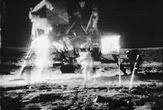
The highest-quality television signal from Apollo 11’s touchdown zone in the moon's Sea of Tranquility—from an antenna mounted atop the Eagle lunar lander—was recorded on telemetry tapes at three tracking stations on Earth: Goldstone in California and Honeysuckle Creek and Parkes in Australia.
Scads of the tapes were produced—and now a search is on to locate them. And if recovered and given a 21st century digital makeover, they could yield a far sharper view of that momentous day, compared to what was broadcast around the globe.
But Apollo 11 is a memory rewind—now over 37 years old. Nobody is quite sure just how much longer the original slow-scan tapes will last … that is, if they haven’t already been erased.
Handled and archived
“I would simply like to clarify that the tapes are not lost as such, which implies they were badly handled, misplaced and are now gone forever. That is not the case,” explained John Sarkissian, operations scientist at the Commonwealth Scientific and Industrial Research Organization’s (CSIRO) Parkes Radio Observatory in Parkes, Australia.
Sarkissian said the tapes were appropriately handled and archived in the mid 1970’s after the hectic activity of the Apollo lunar landing era was over. “We are confident that they are stored at [NASA’s] Goddard Space Flight Center [in Greenbelt, Maryland] … we just don’t know where precisely,” he told SPACE.com. It is important to note, Sarkissian added, that there is no inference of wrong-doing, incompetence or negligence on the part of NASA or its employees.
“The archiving of the tapes was simply a lower priority during the Apollo era. It should be remembered, that at the time, NASA was totally focused on meeting its goal of putting a man on the Moon and returning him safely to the Earth. No sooner had they done that, than they had to repeat it again a few months later, and then do it again, repeating it for a total of seven lunar landing missions … including Apollo 13,” Sarkissian pointed out.
Making it tough to track down the whereabouts of the data, many of those involved in the archiving of the tapes have since moved on, retired or passed away, “taking their corporate memory of where the tapes are with them,” Sarkissian said.
It is important not to exaggerate the quality of the images being sought, Sarkissian added. “The SSTV was not like modern high definition TV and nor was it even equal in quality to the normal broadcast TV we are accustomed to viewing,” he said.
Still, the SSTV was better than the scan-converted images that were broadcast at the time—which is the only version currently available, Sarkissian concluded."




No comments:
Post a Comment